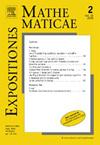基于时空采样的离散动力系统周期源检测
IF 0.9
4区 数学
Q2 MATHEMATICS
引用次数: 0
摘要
本文研究了一个由x(n+1)=Ax(n)+w(n)定义的离散动力系统,其中x取Hilbert空间H中的值,w是一个周期源,其值在H的固定闭子空间w中。我们的目标是找出在某个空间采样系统G={gj}j∈j (H)上,能够从时空样本{< x(n),gj >}n≥0,j∈j中稳定恢复未知源项w的条件。我们给出了G={gj}j∈j的充分必要条件,以保证任意w∈w的稳定回收。此外,我们显式构造了一个依赖于G的算子R,使得R{< x(n),gj >}n,j=w。本文章由计算机程序翻译,如有差异,请以英文原文为准。
Periodic source detection in discrete dynamical systems via space–time sampling
In this paper, we examine a discrete dynamical system defined by , where takes values in a Hilbert space and is a periodic source with values in a fixed closed subspace of . Our goal is to identify conditions on some spatial sampling system of that enable stable recovery of the unknown source term from space–time samples . We provide necessary and sufficient conditions on to ensure stable recovery of any . Additionally, we explicitly construct an operator , dependent on , such that .
求助全文
通过发布文献求助,成功后即可免费获取论文全文。
去求助
来源期刊
CiteScore
1.30
自引率
0.00%
发文量
41
审稿时长
40 days
期刊介绍:
Our aim is to publish papers of interest to a wide mathematical audience. Our main interest is in expository articles that make high-level research results more widely accessible. In general, material submitted should be at least at the graduate level.Main articles must be written in such a way that a graduate-level research student interested in the topic of the paper can read them profitably. When the topic is quite specialized, or the main focus is a narrow research result, the paper is probably not appropriate for this journal. Most original research articles are not suitable for this journal, unless they have particularly broad appeal.Mathematical notes can be more focused than main articles. These should not simply be short research articles, but should address a mathematical question with reasonably broad appeal. Elementary solutions of elementary problems are typically not appropriate. Neither are overly technical papers, which should best be submitted to a specialized research journal.Clarity of exposition, accuracy of details and the relevance and interest of the subject matter will be the decisive factors in our acceptance of an article for publication. Submitted papers are subject to a quick overview before entering into a more detailed review process. All published papers have been refereed.

 求助内容:
求助内容: 应助结果提醒方式:
应助结果提醒方式:


